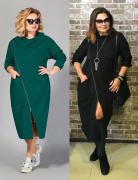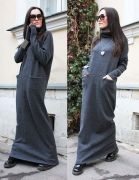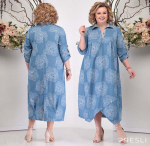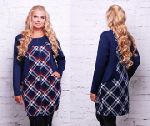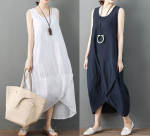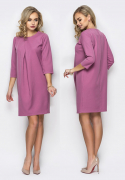Size charts What is the height of the pattern Payment methods Ask a question Reviews

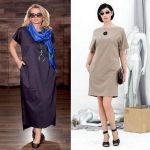 PDF pattern for printing on a printer or plotter in full size for dress sizes from 40 to 52.
PDF pattern for printing on a printer or plotter in full size for dress sizes from 40 to 52.
In the photo, look at the version of the sewn dress according to this pattern by my subscriber Vera Secretareva.
 Download free instructions on how to sew to the pattern of this dress...
Download free instructions on how to sew to the pattern of this dress...
 Buy and download this dress pattern
Buy and download this dress pattern
How to sew a cocoon dress with your own hands according to the finished pattern
- Description of the set of patterns and the style of the dress.
- Consumption and choice of fabric for the dress.
- How to download and print patterns.
- How to cut a cocoon dress according to a pattern.
- How to sew a dress with your own hands step by step:
Buy and download this dress pattern
Description of the pattern, set and style of the dress
Electronic pattern of the dress "cocoon" pockets in the side seams.
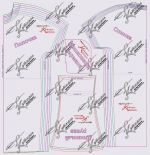 Sizes: 40-52 (buyer gets ALL sizes).
Sizes: 40-52 (buyer gets ALL sizes).
File format for download in order:
PDF in full size and without seam allowances.
After paying for the order, you will receive links to download two files dress patterns gradation sizes from 40 to 52:
- PDF file A4, adapted for printing patterns on sheets of A4 paper in any program on any device, including mobile phones.
- Multi-format PDF file for printing on sheets of any size from A0 to A4 on a printer or plotter using Adobe Reader.
The level of complexity of sewing is simple - a model for sewing for beginners.
This style of dress is suitable only for slender girls with narrow hips.
The set of patterns for a cocoon dress with pockets in the side seams includes (picture 1):
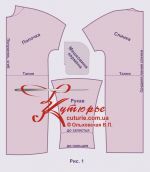 patterns of the back, shelves, sleeves and pocket burlap.
patterns of the back, shelves, sleeves and pocket burlap.
Collars "stand" and "collar" are not included in the set of patterns, as it is a strip of fabric. Read about how to cut a “stand” and “collar” below in the description of cutting and sewing.
Consumption and choice of fabric for the dress
The cost of a “cocoon” dress with pockets in the side seams with a fabric width of 140 cm will be up to 150 cm, depending on the length of the sleeve and the size of the product.
Consumption with a fabric width of 180 cm will decrease to about 110 cm.
Only stretch fabrics are suitable for sewing this dress. You can use the footer, and fleece, and jersey, and other knitwear.
Particular attention should be paid to the choice of size, since the dress of this model can be of a very small volume, closer to the "turtleneck". But you can also sew a very loose "cocoon" to wear it on a sweater.
From the equipment you will need a household sewing machine with an adjustable zigzag and a modern overlocker to make a knitted seam.
How to download and print the patterns of this cocoon dress
How to buy an electronic pattern
How to print a life size pattern at home on A4 sheets
How to choose a pattern size without taking measurements and using tables
 Buy and download this dress pattern
Buy and download this dress pattern
How to cut a cocoon dress with pockets of fabric of different widths
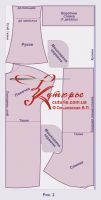 A "cocoon" dress with pockets in the side seams is ideal for those who want to learn how to sew clothes from scratch at home and are at the beginning of learning.
A "cocoon" dress with pockets in the side seams is ideal for those who want to learn how to sew clothes from scratch at home and are at the beginning of learning.
No seam allowances are required. To process the bottom, an allowance is needed only if you decide to process it “into a hem” - overcast and fold it once.
Does this dress need a zipper? If the fabric and seams are elastic enough, then no. If you decide to sew a dress with a fastener, then it can be not only a “lightning”, but also an ordinary “droplet” at the back.
Before cutting, check the length. To reduce the length of the dress, fold the patterns of the back and the top of the shelf along the waist line and lay in the warehouse, removing the excess length.
And to correct the length of the sleeve, the sleeve is measured according to the pattern from the side point of the neck along the shoulder, and the length of the sleeve itself is added to the resulting length. To avoid errors, it is advisable to compare the length of the sleeve with the length of the sleeve of the finished product.
Now about how to cut a dress made of fabric with a width of 140-150 cm (picture 2).
The fabric is folded in half face to face, the edges are aligned and parallel to the edge of the cutting table.
Patterns are stacked in the most economical way. The back - to the edges, the shelf to the fold.
To determine the exact lengthwise direction of the sleeve, fold the pattern lengthwise, aligning the "vertical" cuts - the fold line will be the shareline. This rule applies to all non-stop arms.
"Rack" (or "collar"), as mentioned earlier - a strip of fabric, a rectangle.
Width of the pattern of the rack (clamp) = double the width of the rack (clamp) in finished form + 1 cm
With the length of the workpiece, everything is not so simple.
Stand length = product neck length minus 2 cm
Collar length = product neck length
In other words, the collar should be cut out after you have processed the shoulder seams and measured the neckline. By the way, if desired, the neck can be expanded and deepened. For a rack, no more than 1 cm, for a clamp - 2-3 cm.
You can also refuse collars and make a “boat” neckline, which is indicated on the pattern with thin lines.
 An economical cutting of a “cocoon” dress made of 180 cm wide fabric is shown in picture 3.
An economical cutting of a “cocoon” dress made of 180 cm wide fabric is shown in picture 3.
So, do not forget - it is better to cut out the collar after processing the shoulder seams, and you will need 4 pieces for the burlap pockets.
How to sew a cocoon dress with your own hands for beginners step by step
As mentioned above, you can’t do without elastic “knitted” seams. Modern overlockers can do several of these stitches.
Even if you plan on making a closure at the back, regular straight stitches can burst in the sock, and the look of the product will suffer. Therefore, only knitted!
We start sewing with processing the pocket - we sew the burlap to the shelf and to the back at waist level or 2-4 cm below it.
How to make sure that all 4 burlap are sewn on the same level?
First, folding the back and shelf in half, lay them on top of each other, aligning the waist and bottom lines. Mark the place for stitching the burlap and make notches on all 4 sections. The length of the notches is not more than 0,5 cm.
Now you can sew the burlap pockets with a knitted seam on an overlock, guided by the notches. After stitching, carefully iron the seams.
After sewing the pockets, sew the middle seam of the back and proceed to sewing the shoulder seams. When stitching the shoulder seams, do not forget to put a "edge" under them.
You can get by with a strip of thin stretch or a narrow strip of stretch dublerin. The seams stitched on the overlock are carefully ironed.
Then, we move on to stitching the sleeves. The sleeve in this dress model is non-stop, that is, it does not need to be sewn in - we immediately sew it in! The seam is ironed down.
Having ironed, we can proceed to the grinding of the side seams or to the processing of the neck - as it suits you. The side seams are also carefully ironed and should be slightly stretched under the armpits.
Three ways of processing the neck in this dress
Now let's look at three possible ways to process the neck: inlay, facing and collar "stand" or "collar".
The easiest way to process the neck in a dress made of stretch fabric is trim processing, that is, a transverse strip of the same fabric.
See how to process the neck with a stretch inlay (Photo 2, picture 3 link)
If you are processing a boat neckline turning, then you can cut them out, both according to patterns and according to the product. The “boat” cutout is applied to the drawing with thin lines.
And if you have planned a collar "rack" or "clamp”, measure the resulting neck length. It can be increased by cutting "in a circle" 0,5 - 1 cm for the rack or leave it as it is. For a clamp, you need a wider neck - cut in a circle of 2 - 3 cm.
Processing a fastener for a cocoon dress
If necessary, we process the fastener. The simplest option is a "cut" or "drop".
The collar is cut out based on the length of the neck, as already mentioned. The width of the stand collar in finished form can be from 3 to 10 cm, that is, the width of its blank is from 6 to 20 cm. The width of a small collar in the finished video is from 25 to 20 cm.
The cut collar, fold in half lengthwise and iron. If the dress has a fastener, we process the ends separately - we grind and turn it inside out. For wide collars, arbitrary soft folds can be made.
If the dress is without a fastener, we grind the collar into a “ring” with a narrow zigzag, iron the seam. Once again, we check whether we can put on a collar without a fastener.
We sew the finished collar into the neck.
To make our task as easy as possible, we first cut off the collar and neck with pins: first, the middle points, then we divide the halves (without taking into account the position of the shoulder seams) and again we cut off the middle points.
Having chipped the collar and neck, we fasten the ends of the collar and drops with a narrow zigzag, and then we sew the collar completely on the overlock.
A closed collar is easier to sew, but here the requirements for the line itself increase. Modern overlocks can be rebuilt on the so-called "stretch" lines. For a closed collar, one of these is suitable.
Stitching a closed collar should be slightly stretched, and after stitching, carefully iron the seam on the pillow so that the seam does not bulge.
Ironing the seam of the collar is also needed for a collar with a clasp.
The seam allowance, especially if the collar is narrow, it is advisable to hem to the shelf manually or on a typewriter, without tightening the seam.
The bottom of the sleeves and the bottom of the dress can be processed into an open hem - folded once, using a cover stitch, a wide zigzag, a double needle stitch or any elastic decorative stitch.
See video master class how to set up an overlock and sew knitwear
In addition, it is permissible to simply overcast the bottom of the dress and the bottom of the sleeves on an overlock.
Download this pattern pdf:
Dress pattern "cocoon" pockets in the side seams
$2.00 (80 hryvnia)
Bank cards of the Russian Federation are not accepted for payment!
Size charts What is the height of the pattern Payment methods Ask a question Reviews
Vera Olkhovskaya in social networks:

See similar clothing patterns and how to sew on them
-
Any pattern for free for a review of a previously made order
More...
Lifetime promotion for buyers of patterns!

Leave a review about my store of patterns for an order that you made before, and you will receive any paid pattern of your choice Free!


